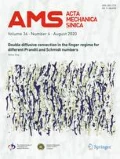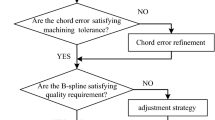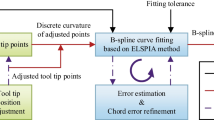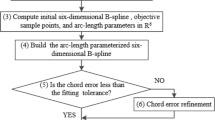Abstract
In order to avoid stress concentration, the shape boundary must be properly designed via shape optimization. Traditional shape optimization approach eliminates the stress concentration effect by using free-form curve to present the design boundaries without taking the machinability into consideration. In most numerical control (NC) machines, linear as well as circular interpolations are used to generate the tool path. Non-circular curves, such as nonuniform rotational B-spline (NURBS), need other more advanced interpolation functions to formulate the tool path. Forming the circular tool path by approximating the optimal free curve boundary with arcs or biarcs is another option. However, these two approaches are both at a cost of sharp expansion of program code and long machining time consequently. Motivated by the success of recent researches on biarcs, a reliable shape optimization approach is proposed in this work to directly optimize the shape boundaries with biarcs while the efficiency and precision of traditional method are preserved. Finally, the approach is validated by several illustrative examples.
Similar content being viewed by others
References
Ding, Y.: Shape optimization of structures: A literature survey. Computers and Structures 24, 985–1004 (1986)
Wu, Z.X.: An efficient approach for shape optimization of components. International Journal of Mechanical Science 47, 1595–1610 (2005)
Miegroet, V.L., Duysinx, P.: Stress concentration minimization of 2D filets using X-FEM and level set description. Struct. Multidisc. Optim. 33, 425–438 (2007)
Zhang, W.H., Beckers, P., Fleury, C.: A unified parametric design approach to structural shape optimization. Int. J. Numer. Methods Eng. 38, 2283–2292 (1995)
Olafsson, G.: Shape design of holes in vibrating rectangular plates, [Master Thesis]. Solid Mechanics, DYU (2000)
Gong, L.X.: Parametric shape modeling using deformable super ellipses for prostate segmentation. IEEE Transactions on Medical Imaging 23, 340–349 (2004)
Hallonborg, U.: Super ellipse as tyre-ground contact area. Journal of Terramechanics 33, 125–132 (1996)
Wang, D.: Sensitivity analysis and shape optimization of a hole in a vibrating rectangular plate for eigenfrequency maximization. Journal of Engineering Mechanics 138, 662–674 (2012)
Khurasia, H.B., Rawtani, S.: Vibration analysis of circular plates with eccentric hole. J. Appl. Mech. 45, 215–217 (1978)
Bletzinger, K.U., Ramm, E.: Structural optimization and form finding of light weight structures. Computers and Structures 79, 2053–2062 (2001)
Versprille, K.J.: Computer-aided design applications of the rational b-spline approximation form, [Ph.D. Thesis]. Syracuse Univeristy Syracuse, NY, USA (1975)
Gardiner, M.: The super ellipse: A curve that lies between the ellipse and the rectangle. Sci. Am. 21, 222–234 (1965)
Huang, J.T., Yang, D.C.H.: Precision command generation for computer controlled machines, precision machining: Technology and machine development and improvement. ASME PED. 58, 89–104 (1992)
Piegl, L.A., Tiller, W.: Biarc approximation of NURBS curves. Computer-Aided Design 34, 807–814 (2002)
Piegl, L.A., Tiller, W.: The NURBS Book. Springer-Verlag, Berlin (1997)
Pedersen, N.L.: Optimization of holes in plates for control of eigenfrequencies. Structural and Multidisciplinary Optimization 28, 1–10 (2004)
Rui, J.Z., Wu, Z.X.: Study of optimization of the fillet curve, [Master Thesis]. Yangzhou University, China (2010)
Zhang, W.H.: Sensitivity analysis and structural shape optimization by finite element method, [Ph.D. Thesis]. University of Liege, Belgium (1991)
Zhang, W.H.: A parametric mapping method for curve shape optimization on 3D panel structures. Int. J. Numer. Meth. Engng. 84, 485–504 (2010)
Piegl, L.A.: The NURBS Book, (2nd edn). Springer Verlag, New York (1997)
Xia, L., Zhu, J.H., Zhang, W.H.: Sensitivity analysis with the modified Heaviside function for the optimal layout design of multi-component systems. Computer Methods in Applied Mechanics and Engineering. 241–244, 142–154 (2012)
Svanberg, K.: A globally convergent version of MMA without linesearch. In: Proc. of the First World Congress of Structural and Multidisciplinary Optimization. Pergamon: New York, 9–16 (1995)
Author information
Authors and Affiliations
Corresponding author
Additional information
The project was supported by the National Natural Science Foundation of China (90916027, 11002113, 51275424, and 11172236), 973 Program (2011CB610304), the 111 Project (B07050), the NPU Foundation for Fundamental Research (JC20120229).
Rights and permissions
About this article
Cite this article
Meng, L., Zhang, WH., Zhu, JH. et al. A biarc-based shape optimization approach to reduce stress concentration effects. Acta Mech Sin 30, 370–382 (2014). https://doi.org/10.1007/s10409-014-0053-6
Received:
Revised:
Accepted:
Published:
Issue Date:
DOI: https://doi.org/10.1007/s10409-014-0053-6




